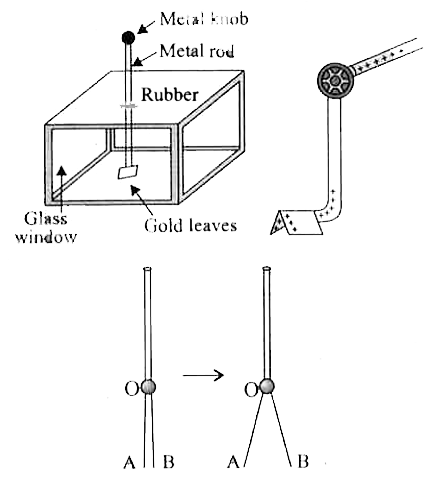When a negative charged rod is brought near, but does not touch, the initially unchanged electroscope shown below, the leaves spring apart (I). When the electroscope is then touched with a finger, the leaves collapse (II). When next the finger and finally the rod are removed, the leaves spring apart a second time (III). The charge on the leaves is

positive in both I and III
negative in both I and III
positive in I, negative in III
negative in I, positive in III
The correct Answer is:D
Due to induced effect.
Topper's Solved these Questions
- MISCELLANEOUSBook:ALLENChapter:MISCELLANEOUSExercise:Exersice-03
Explore 7 Videos
- MISCELLANEOUSBook:ALLENChapter:MISCELLANEOUSExercise:ASSERTION-REASON
Explore 18 Videos
- MISCELLANEOUSBook:ALLENChapter:MISCELLANEOUSExercise:Part -II Example Some worked out Examples
Explore 1 Video
- KINEMATICS (MOTION ALONG A STRAIGHT LINE AND MOTION IN A PLANE)Book:ALLENChapter:KINEMATICS (MOTION ALONG A STRAIGHT LINE AND MOTION IN A PLANE)Exercise:BEGINNER S BOX-7
Explore 8 Videos
- PHYSICAL WORLD, UNITS AND DIMENSIONS & ERRORS IN MEASUREMENT Book:ALLENChapter:PHYSICAL WORLD, UNITS AND DIMENSIONS & ERRORS IN MEASUREMENT Exercise:EXERCISE-IV
Explore 8 Videos
Similar Questions
When a glass rod rubbed with silk is brough near the knob of a positively charged gold leaf electroscope , the gold leaves
View SolutionWhen a negatively charged ebonite rod is brought close to an uncharged electroscope, the leaves of the electroscope develop positive charge and diverge.
View SolutionA negatively charged rod is held close to the disc of a neutral gold leaf electroscope. What kind of charge is produced on the
disc
gold leaves ?
View SolutionWhen the disc of GLE is touched with positively charged glass rod the charge on the leaves of GLE is :
View SolutionWhat will happen to the leaves of an electroscope if a positively charged body is brought near
(a) An uncharged electroscope ?
(b) A positively charged electroscope ?
( c ) A negatively charged electroscope ?
View SolutionAn electroscope is given a positive charge, causing its foil leaves to separate. When an object is brought near the top plate of the electroscope, the fiols separated even further. We conclude.

View SolutionA leaf electroscope is a simple apparatus to detect any charge on a body. It consist of two metal leaves OA and OB, free to rotate about O. Initially both are very slighty separted. When a charged object is touched to the metal knob at the top of the conduction re, charge flows from knob to the top of the conduction rod, charge flows from knob to the leaves through the conducting rod, charge flows from knob to the leaves through the conduction rod. As the leaves are now charged similarly, they start repelling each other and tet separted (deflected by certain angle).

The angle of deflection in static equilibrium is an indicator of the amount of charge on the charged boy.
When a+20C rod is touched to the knob, the deflection of leaves was 5∘, and when an identical rod of −40C is touched, the deflection was found to be 9∘. If an identical rod of +30C is touched, then the deflection may be:
View SolutionA leaf electroscope is a simple apparatus to detect any charge on a body. It consist of two metal leaves OA and OB, free to rotate about O. Initially both are very slighty separted. When a charged object is touched to the metal knob at the top of the conduction re, charge flows from knob to the top of the conduction rod, charge flows from knob to the leaves through the conducting rod, charge flows from knob to the leaves through the conduction rod. As the leaves are now charged similarly, they start repelling each other and tet separted (deflected by certain angle).

The angle of deflection in static equilibrium is an indicator of the amount of charge on the charged boy.
If we perform these steps one by one.


In which case, the leaves will converge (come closer), as compared to the previous state?
View SolutionA negatively charged particle enters in a semi-infinite uniform magnetic field vecB, directed out the plane of paper as shown in the figure. Through what angle it is is deviated when it leaves the magnetic field?
View SolutionComponents of loudspeaker :
A loudspeaker consists of permanent magnets, basket, voice cails, flexible supension & rigid speaker cone as shown in figure.

Loudspeaker principle
A light voice coil is mounted so that it can move freely inside the magnetic field of a strong permanent magnet. the paper cone is attached to the voice coil and attached with a flexble mounting to the outer ring of the support .Because there is a definite equilibrium position for the speaker cone and there is elasticity of the mounting structure, there is inevitably a free cone resonant frequency like of a mass on a spring. The frequency can be determined by adjusting the mass and stiffness of the cone and voice coil

Working :
The ratio drives a rapidly changing current through the coil. The current follows that vibrations of speech and the electromagnetic force follows the current changes, pushing the paper cone. Finally the air in front of the loudspeaker is set into vibration following the cone's motion, and sound waves are transmitted to the listener
With reference to the figure of Q.& when the current in the coil is given by I=Iccos(2000πt) where t is in seconds. the coil will experience magnetic force in the positive y-direction in the time intervals of : (Take the initial direction of cirrent shown in figure to be positive)
View Solution

